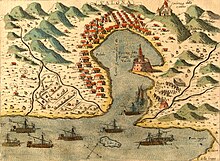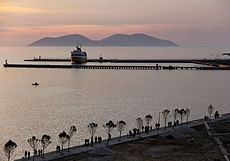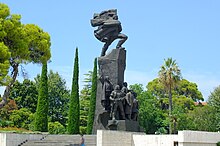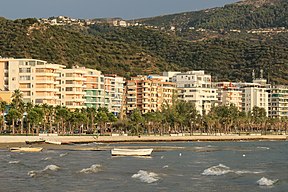Vlorë
Vlorë | |
|---|---|
Municipality and city | |
From top to bottom, left to right: Promenade of Vlorë, Muradie Mosque, Old house on the Dhimiter Konomi Street, Old Town of Vlorë, Independence Monument and Lungomare. | |
|
UTC+2 (CEST) | |
| Postal code | 9400 |
| Area code | +355 (0) 33 |
| Seaport | Port of Vlorë |
| Motorways | |
| Highways | |
| Vehicle registration | VL |
| Website | vlora |
Vlorë (
The coastal area of Vlorë was one of those
Between the 18th and 19th centuries, the
Vlorë is one of the most significant cities of southern Albania and the region of Labëria which is traditionally noted for its culture, traditions and folklore. Vlorë is served by the Port of Vlorë, the SH8 highway, and the A2 motorway, collectively representing part of the Adriatic–Ionian Corridor and the Pan-European Corridor VIII.
Name
The city took its name from
Vlorë developed from the ancient Aulon-a through the evolution of the
The medieval and modern Greek name is Avlónas (Αυλώνας Aulṓnas
History
Historical affiliations
Ancient Greeks
Roman Empire, 226 BCE–286
Byzantine Empire, 286-c. 705
South Slavs, c. 705–784
Byzantine Empire, 784–1204
Despotate of Epirus, 1204-1346
Principality of Valona, 1346–1417
League of Lezhë 1443-1478
Ottoman Empire, 1417–1691
Republic of Venice, 1691–1698
Ottoman Empire, 1698–1912
Independent Albania, 1912–1914
Principality of Albania, 1915–1917
Italian protectorate over Albania, 1917–1920
Principality of Albania, 1920–1925
Albanian Republic, 1925–1928
Albanian Kingdom, 1928–1939
Kingdom of Albania, 1939–1943
Albanian Kingdom, 1943–1944
Democratic Government of Albania, 1944–1946
People's Socialist Republic of Albania, 1946–1992
Albania, 1992–present
Early history
The coastal area of Vlorë was one of those Illyrian sites that had experienced pre-urban activity beginning from the 11th–10th centuries BCE.[18] During the period of Euboean colonization of the area (early 8th century BC) the bay of Vlorë was associated with several Heroic traditions and the foundation of several settlements there,[19] as the toponym Aulon suggest which is also known in local Eubean toponimity.[20]
Due to its strategic position on the
The archaeological site of Triport has been identified with ancient
Aulon (Avlona) became an episcopal see in the 5th century. Among the known bishops are Nazarius in 458 and Soter in 553 (Daniele Farlati, Illyricum sacrum, VII, 397–401). The diocese at that time belonged to the papal Pentarchy. In 733, it was annexed with the eastern Illyricum, to the Patriarchate of Constantinople, and yet it is not mentioned in any Notitiae Episcopatuum of that Church. The bishopric had probably been suppressed for though the Bulgarians had been in possession of this country for some time, Avlona is not mentioned in the "Notitiae episcopatuum" of the Bulgarian Archbishopric of Ohrid.
During the Roman period, a Latin see was established and Eubel (Hierarchia catholica medii aevi, I, 124) mentions several of its bishops.[28]
Aulon, no longer being a residential bishopric, is today listed by the Catholic Church as a titular see, a suffragan bishop of Durrës, being distinguished from a Greek titular see called Aulon by the use for it of the adjective Aulonitanus, while the adjective regarding the Aulon in Euboea (Ionian Greece) is Aulonensis.[30] The diocese was nominally restored as Latin titular bishopric Aulon, or Valona in Curiate Italian; from 1925 it was (als) named Aulona in Latin and/or Italian, since 1933 it's only Aulon in Latin, Aulona in Italian. It was a bishopric from the fifth century until Bulgarian rule.
Middle Ages
In the 11th and 12th century, Vlorë played an instrumental role in the conflicts between the Byzantine Empire and Norman Kingdom of Sicily.[15] Following Norman occupation, they ruled for only four years and established a Latin church episcopal see in Vlorë.[15][31] In 1321 the city being under Byzantine control was attacked by a Venetian fleet under Giovanni Michiel as a result costing the lives of many of its Greek inhabitants.[32] Vlorë served as capital of the Principality of Valona, initially a Serbian vassal state and later, independent Christian state from 1346 to 1417.[33][34]
The

In 1426, the Ottomans supported the settlement of a

Albanian Renaissance

Between the 18th and 19th centuries, cultural developments, widely attributed to
On November 28, 1912,
Communist Albania
During the
After World War II, with Albania ruled by a
In 1997, Vlorë was the center of the 1997 Albanian civil unrest after the collapse of several fraudulent investment schemes that led to the downfall of the Sali Berisha administration.
Geography

Vlorë is situated on the
Climate
According to the
During the 1961–1990 period, on average per year, there were 82 days with more than 1 mm (0.039 in) of rainfall, 26 days with thunders, five days with hail, and one day of snowfall.[45]
| Climate data for Vlorë | |||||||||||||
|---|---|---|---|---|---|---|---|---|---|---|---|---|---|
| Month | Jan | Feb | Mar | Apr | May | Jun | Jul | Aug | Sep | Oct | Nov | Dec | Year |
| Mean daily maximum °C (°F) | 13.2 (55.8) |
13.9 (57.0) |
15.9 (60.6) |
19.0 (66.2) |
23.2 (73.8) |
27.0 (80.6) |
29.7 (85.5) |
29.8 (85.6) |
27.0 (80.6) |
22.8 (73.0) |
18.2 (64.8) |
14.5 (58.1) |
21.2 (70.1) |
| Daily mean °C (°F) | 10 (50) |
10 (50) |
12 (54) |
15 (59) |
19 (66) |
22 (72) |
25 (77) |
25 (77) |
22 (72) |
19 (66) |
15 (59) |
12 (54) |
17 (63) |
| Mean daily minimum °C (°F) | 4.8 (40.6) |
5.3 (41.5) |
6.6 (43.9) |
9.6 (49.3) |
13.2 (55.8) |
16.6 (61.9) |
18.4 (65.1) |
18.3 (64.9) |
15.9 (60.6) |
12.5 (54.5) |
9.5 (49.1) |
6.3 (43.3) |
11.4 (52.5) |
| Average precipitation mm (inches) | 113.5 (4.47) |
86.3 (3.40) |
90.4 (3.56) |
65.3 (2.57) |
56.8 (2.24) |
19.1 (0.75) |
12.4 (0.49) |
21.1 (0.83) |
69.2 (2.72) |
124.1 (4.89) |
138.4 (5.45) |
145.0 (5.71) |
941.6 (37.08) |
| Average precipitation days | 13 | 12 | 14 | 11 | 9 | 6 | 3 | 3 | 5 | 10 | 17 | 17 | 120 |
| Mean monthly sunshine hours | 133.3 | 147.9 | 173.6 | 225.0 | 272.8 | 318.0 | 368.9 | 344.1 | 279.0 | 210.8 | 117.0 | 99.2 | 2,689.6 |
| Mean daily sunshine hours | 4 | 5 | 5 | 7 | 8 | 10 | 11 | 11 | 9 | 6 | 3 | 3 | 7 |
| Mean daily daylight hours | 9 | 10 | 11 | 13 | 14 | 15 | 14 | 13 | 12 | 11 | 9 | 9 | 12 |
| Source 1: NOAA[45]
| |||||||||||||
| Source 2: [44][48] | |||||||||||||
Economy

The city of Vlorë remains a major seaport and commercial centre, with a significant
Vlorë is a vibrant coastal city with a well-developed and modern housing infrastructure. The city offers a variety of residential areas ranging from the coast and going inland. Vlorë is divided into three economic zones.[49] The Free Economic Zone TEDA Vlorë has a strategic location, some 151 kilometres (94 miles) away from the capital Tirana. The Land and Environmental Information is located in a flat, saline land, partially covered by Soda Forest. The area is suitable for industrial and environmentally friendly development. The Industrial development inside the zone eligible activities that can be developed in TEDA are: industrial, processing, commercial, goods storage, light industry, electronics, auto parts manufacturing, and port related activities. The Labor market: Official data from 2014 reported the employable labor force in Vlora at 125,954, of which 84,836 are currently employed. 35% of the labor force in Vlora has a high school degree, while 17% has a university degree.
According to the
Tourism which has always been a driving force for the city's economy has become a major industry in recent years, with many hotels, recreational centers, and vast beaches. The city has a good view over the
In April 2024, it was reported that Jared Kushner, son-in-law and former aide to US President Donald Trump, planned to build a resort in the city as part of plans of his company, Affinity Partners, to invest in the Balkans.[52]
Infrastructure
Transport
Vlorë lies on the north–south transportation corridor of Albania and is served by a network of motorways and highways connecting the city to other parts of Albania. The preceding
Vlorë is served by the Port of Vlorë, the second busiest port in Albania, located in the northern part of the city's coast.
The
The
Education
Vlora is home to the second largest university in Albania. The
There are three journals based in the University of Vlora. There is also a scientific journal published quarterly in Albanian: Buletini Shkencor i Universitetit te Vlorës. Since 2008 it is home to the Academicus International Scientific Journal,[64] a peer-reviewed scientific publication in the English language founded by Arta Musaraj.[65]
Besides the state university there are two private universities, namely
Demography
| Population history of Vlorë in selected periods | ||||||
|---|---|---|---|---|---|---|
| Year | 1923[67] | 1927[67] | 1938[67] | 1989[42] | 2001[42] | 2011[6] |
| Pop. | 5,942 | 6,210 | 9,948 | 71,662 | 77,652 | 79,513 |
| ±% p.a. | — | +1.11% | +4.38% | +3.95% | +0.67% | +0.24% |
| Source: [67] | ||||||
As per the Institute of Statistics estimate from the 2011 census, there were 79,513 people residing in Vlorë and 104,827 in the municipality of Vlorë, constituting the third most populous city and fifth most populous municipality of Albania.[1][6] The estimated population density of Vlorë Municipality was at 169.9 inhabitants per square kilometre.[1] The population of Vlorë had increased from 71,662 in 1989 to 79,513 in 2011, while a decline of the population of Vlorë Municipality from 114,497 to 104,827 was highlighted.[42]
The constitution defines Albania as a secular country with no
Culture

Vlorë is geographically and culturally encompassed in the historical region of

Vlorë is home to many cultural and historical sites that also relate to the founding of Albania. The Monument of Independence is located on the Flag's Square and commemorates the Albanian independence from the Ottoman Empire.[76] Museum of Independence is housed in a 19th-century building, where the founding fathers of Albania signed the Declaration of Independence.[77] Its balcony is considered a symbol of freedom, victory and resilience of the Albanians to prevent the occupation of their motherland.[77]
Located in a 19th-century mansion, the Ethnographic Museum close to the Museum of Independence displays the ethnographic heritage of Vlorë and its surrounding region.[77] The History Museum at the Perlat Rexhepi Street is another museum exhibiting among others artefacts from the nearby archaeological sites of the Illyrians and Ancient Greeks.[77] A museum dedicated to the historical Jewish population of Vlorë is planned to open in the historical center of Vlorë.[78][79]
Among the most outstanding religious sites in Vlorë are the
The oldest and most popular first division team based in Vlorë is the football club
International relations
Vlorë is twinned with:
 Hollywood, Florida, United States[80]
Hollywood, Florida, United States[80] Yangzhou, China[81]
Yangzhou, China[81]
See also
Notes
- ^ The municipality of Vlorë consists of the administrative units of Novoselë, Orikum, Qendër Vlorë, Shushicë and Vlorë.[1][4][5] The population of the municipality results from the sum of the listed administrative units in the former as of the 2011 Albanian census.[1][6]
- ^ The estimation for the administrative unit of Vlorë is to be taken into consideration.[6]
- ^ Vlorë is also known as Vlonë (pronounced [ˈvlonə]; definite: Vlona) in Gheg Albanian.[9]
- ^ "town that is the second seaport of Albania. It was strategically important during the Roman period and in the 11th to the 12th-century wars between Normans and the Byzantine Empire" (EB editors 2016).
References
- ^ a b c d e f g h "Pasaporta e Bashkisë Vlorë" (in Albanian). Porta Vendore. Archived from the original on 23 September 2021. Retrieved 23 September 2021.
- ^ "Bashkia Vlorë" (in Albanian). Albanian Association of Municipalities (AAM). Archived from the original on 23 September 2021. Retrieved 23 September 2021.
- ^ "Rregullore e Planit të Përgjithshëm Vendor të Territorit të Bashkisë Vlorë" (PDF) (in Albanian). Bashkia Vlorë. p. 15. Archived (PDF) from the original on 23 September 2021. Retrieved 23 September 2021.
- ^ a b "A new Urban–Rural Classification of Albanian Population" (PDF). Instituti i Statistikës (INSTAT). May 2014. p. 15. Archived from the original (PDF) on 14 November 2019. Retrieved 23 September 2021.
- ^ a b "Law nr. 115/2014" (PDF) (in Albanian). p. 6376. Retrieved 25 February 2022.
- ^ a b c d Nurja, Ines. "Censusi i popullsisë dhe banesave/ Population and Housing Census–Vlorë (2011)" (PDF). Tirana: Institute of Statistics (INSTAT). p. 85. Archived (PDF) from the original on 13 June 2020. Retrieved 23 September 2021.
- ^ "Vlorë". Lexico UK English Dictionary. Oxford University Press. Archived from the original on 2020-07-07.
- ^ "Vlorë". The American Heritage Dictionary of the English Language (5th ed.). HarperCollins. Retrieved 5 July 2020.
- ISBN 0-85229-290-2. Archivedfrom the original on 7 November 2020. Retrieved 23 September 2021.
- ISBN 978-9609582148.
ηκαν το αρχ. δίαυλος «πέρασμα, δίοδος» και το νεότ. πύραυλος. Η κοιλάδα που μοιάζει με αυλό λέγεται αυλών (αυλώνας). από όπου το συχνό τοπωνύμιο Αυλών | Αυλώνα, ... Αυλώνας (ο) πόλη και λιμάνι τής Ν. Αλβανίας
- ^ ISBN 9789994381715. Archived from the originalon 20 November 2020.
- ISBN 978-9027933058.
- JSTOR 40848841.
- ^ "Baynes, T. S., ed. (1875–1889). . Encyclopædia Britannica (9th ed.). New York: Charles Scribner's Sons." in the Encyclopædia Britannica, 9th ed. 1878.
- ^ a b c d e Chisholm 1911.
- ISBN 978-1-84511-287-5. Google Book Search. Retrieved on August 25, 2009.
- ^ "Arumunët Albania, nr. 40". Arumunët Albania (in Albanian and Aromanian). No. 40. 2014. p. 15.
- ^ Bereti 1993, p. 143.
- ^ Stocker, Sharon R. (2009). Illyrian Apollonia: Toward a New Ktisis and Developmental History of the Colony. p. 227.
Heroic origins that involved Euboeans were attributed toseveral other early settlements around the Bay of Vlora
- ISBN 978-1-134-45098-5.
Eretrians settled around the bay of Avlona (Aulona).... There was also a place called Aulon in the Eretrias... and another .... Khalkis.
- ISBN 978-1-78570-232-7.
Then there was the establishment of a new type of site in the Illyrian hinterland, away from the coastal areas usually inhabited by Greeks, especially during the developed Iron Age...
- ^ Bereti 1993, p. 143; Fasolo 2005, p. 178; Volpe et al. 2014, p. 300.
- ^ Volpe et al. 2014, p. 300.
- ^ Fasolo 2005, p. 178.
- ^ Volpe et al. 2014, p. 300; Bereti 1993, p. 143.
- ^ Bereti, Quantin & Cabanes 2011, pp. 11, 13.
- ^ Bereti, Quantin & Cabanes 2011, p. 11.
- ^ a b Vailhé 1912.
- ^ "Apollonia and Aulon in Epirus Nova" (Bowden 2003, p. 14)
- ISBN 978-88-209-9070-1), p. 842
- ISBN 978-99943-56-83-6.
- ISBN 978-0-521-26190-6.
Nicholas Orsini... He stepped up his invasion of Byzantine territory... The Venetians too seem to have decided that the moment was now ripe to help him. They sent a fleet led by Giovanni Michiel to attack Valona. Many of its Greek inhabitants were killed on the spot, including the son of its admiral Gantzas
- ISBN 978-0-19-960060-1.
- ISBN 0-472-10079-3.
- ^ ISBN 9783631602959.
- ^ İnalcik, Halil (1954). Hicr ı835 tarihli sûret-i defter-i sancak-i Arvanid (in Turkish). Türk Tarih Kurumu Yayınlarından.
- ISBN 978-0-521-29163-7.
- OCLC 165705732.
- ^ Hoxha, Enver (1972). The Party of Labor of Albania in Battle with Modern Revisionism: Speeches and Articles. The Naim Frasheri Publishing House.
- ISBN 978-1-78348-735-6.
- ISBN 978-1-85065-279-3.
Vlora ... was notorious as a recruiting ground for the Sigurimi.
- ^ a b c d "Shërbim Konsulence, për Hartimin e Planeve të Përgjithshme Vendore, për Katër Bashki, Vlorë, Sarandë, Himarë, Konispol" (PDF) (in Albanian). Bashkia Vlorë. 30 November 2016. Archived (PDF) from the original on 23 September 2021. Retrieved 23 September 2021.
- ^ a b c d "Climate: Vlorë". Climate-Data. Archived from the original on 21 September 2021. Retrieved 21 September 2021.
- ^ a b "Vlore Climate & Temperature". ClimaTemps. Archived from the original on 24 September 2021. Retrieved 24 September 2021.
- ^ NOAA. Retrieved 23 February 2024.
- )
- ^ Begaj, Majlinda. "Vlora guida".
{{cite journal}}: Cite journal requires|journal=(help) - ^ "What is the Climate, Average Temperature/ Weather in Vlore?". Climatetemp.info. Archived from the original on 21 August 2010. Retrieved 21 September 2021.
- ^ "Albania is creating three free economic zones". emerging-europe.com. 24 August 2015.
- ^ "Subnational Economy Rankings - South East Europe - Subnational Doing Business - World Bank Group". www.doingbusiness.org. Retrieved 15 March 2018.
- ^ "Five destinations to watch — from the Faroe Islands to Pakistan". Financial Times. 8 November 2019. Archived from the original on 2022-12-10. Retrieved 2020-08-31.
- ^ Bytyci, Fatos; Goga, Florion (2024-04-04). "Jared Kushner's planned Albania resort stokes fear and hope in coastal town". Reuters. Retrieved 2024-04-10.
- ^ "Bypass-i Vlorës" (in Albanian). Archived from the original on 22 February 2017. Retrieved 24 September 2021.
- ^ Gjonaj, Arlinda (15 June 2020). "Këtë javë nis asfaltimi i bypass-it të Vlorës/ Rama: Brenda muajit hapet gara ndërkombëtare për 'Korridorin Blu'" (in Albanian). Agjencia Telegrafike Shqiptare (ATA). Archived from the original on 22 June 2021. Retrieved 24 September 2021.
- ^ "History of Hekurudha Shqiptare (in Albanian)". Archived from the original on 2016-10-17. Retrieved 21 June 2020.
- ^ "Europe Trains Guide". Retrieved 15 September 2017.
- ^ "Albania Railway Photographs". Retrieved 20 October 2017.
- ^ "About Albrail". Albrail. Retrieved 21 June 2020.
- ^ "Aeroporti i ri ndërkombëtar i Vlorës" (in Albanian). Kryeministria. Archived from the original on 2 May 2021. Retrieved 24 September 2021.
- ^ "Gati projekti për aeroportin ndërkombëtar të Vlorës" (in Albanian). Kryeministria. Archived from the original on 24 September 2021. Retrieved 24 September 2021.
- ^ "New airport near the Narta Lagoon, Albania". International Union for Conservation of Nature (IUCN). 7 March 2018. Archived from the original on 24 September 2021. Retrieved 24 September 2021.
- ^ "PM Rama announces start of works for Vlora Airport". Albanian Daily News.
- ^ "PM Rama inspects works at construction site of Vlora Airport". Albanian Daily News.
- ISSN 2079-3715.
- ^ "Official Website of Academicus International Scientific Journal".
- ^ "Private Higher Education Institutions in Albania". Archived from the original on 2016-01-26. Retrieved 2013-02-04.
- ^ ISBN 9783643501448. Archived from the originalon 24 September 2021. Retrieved 24 September 2021.
- ^ a b "Constitution of the Republic of Albania". Organization for Security and Co-operation in Europe (OSCE). Archived from the original on 17 April 2021. Retrieved 14 September 2021.
- ^ "Albania 2016 International Religious Freedom Report" (PDF). state.gov. pp. 1–7. Archived from the original (PDF) on 2017-08-15.
- ^ Kokolakis, Mihalis (2003). Το ύστερο Γιαννιώτικο Πασαλίκι: χώρος, διοίκηση και πληθυσμός στην τουρκοκρατούμενη Ηπειρο (1820–1913) [The late Pashalik of Ioannina: Space, administration and population in Ottoman ruled Epirus (1820–1913)]. EIE-ΚΝΕ. p.52. "β. Ο διεσπαρμένος ελληνόφωνος πληθυσμός περιλάμβανε... και μικρό αριθμό οικογενειών στα αστικά κέντρα του Αργυροκάστρου και της Αυλώνας. [b. The scattered Greek-speaking population included ... and a small number of families in the cities of Gjirokastra and Vlora.]"; p. 53. "και την ακόμη ολιγομελέστερη ομάδα των Καθολικών της Αυλώνας [and even group of Catholics in Vlora]"; p. 54. "Η μουσουλμανική κοινότητα της Ηπείρου, με εξαίρεση τους μικρούς αστικούς πληθυσμούς των νότιων ελληνόφωνων περιοχών, τους οποίους προαναφέραμε, και τις δύο με τρεις χιλιάδες διεσπαρμένους «Τουρκόγυφτους», απαρτιζόταν ολοκληρωτικά από αλβανόφωνους, και στα τέλη της Τουρκοκρατίας κάλυπτε τα ¾ περίπου του πληθυσμού των αλβανόφωνων περιοχών και περισσότερο από το 40% του συνόλου. [The Muslim community in Epirus, with the exception of small urban populations of the southern Greek-speaking areas, which we mentioned, and 2-3000 dispersed "Muslim Romani", consisted entirely of Albanian speakers, and in the late Ottoman period covered approximately ¾ of population ethnic Albanian speaking areas and more than 40% of the total area."; pp. 370, 374.
- ISBN 978-0-7656-0528-3.
- ISBN 978-0-8419-0519-1.
- ^ Elsie, Robert. "Der Kanun" (in German). Elsie. Archived from the original on 18 October 2012. Retrieved 24 September 2021.
- United Nations Educational, Scientific and Cultural Organization (UNESCO). Archivedfrom the original on 24 September 2021. Retrieved 24 September 2021.
- ^ Elsie, Robert. "Albanian Dialects: Introduction". Albanian Language. Archived from the original on 16 October 2021. Retrieved 28 October 2021.
- ^ a b c "Çfarë të vizitoni" (in Albanian). Bashkia Vlorë. Archived from the original on 3 March 2021. Retrieved 23 September 2021.
- ^ a b c d "Muzeumet e Vlorës" (in Albanian). Bashkia Vlorë. Archived from the original on 5 March 2021. Retrieved 23 September 2021.
- ^ Alla, Adela (9 August 2020). "Në zonën e rilindur të Vlorës së shpejti dhe Muzeu i Shpëtimit të Hebrenjve" (in Albanian). Agjencia Telegrafike Shqiptare (ATA). Archived from the original on 24 September 2021. Retrieved 24 September 2021.
- ^ "Historia e shpëtimit të hebrenjve me një muze në Vlorë". Telegrafi (in Albanian). 20 August 2020. Archived from the original on 23 August 2020. Retrieved 24 September 2021.
- ^ "Florida Sister Cities". Tampa Bay Protocol & Trade. Retrieved 2021-09-05.
- ^ "Delegacioni i qytetit Yangzhou vizitoi Vlorën" (in Albanian). Embassy of the People's Republic of China in the Republic of Albania. 2016-10-18. Retrieved 2021-09-05.
Bibliography
- Bereti, Vasil (1993). "Gjurmë të fortifikimeve në vendbanimin në Treport / Traces de fortifications dans l'habitat à Treport". Iliria (in Albanian). 23: 143–159. .
- Bereti, Vasil; Quantin, François; Cabanes, Pierre (2011). "Histoire et épigraphie dans la région de Vlora (Albanie)". REA (in French). 113 (1).
- Fasolo, Michele (2005) [2003]. La via Egnatia I. Da Apollonia e Dyrrachium ad Herakleia Lynkestidos. Viae Publicae Romanae (in Italian). Vol. 1. Rome: Istituto Grafico Editoriale Romano.
- Volpe, Giuliano; Disantarosa, Giacomo; Leone, Danilo; Turchiano, Maria (2014). "Porti, approdi e itinerari dell'Albania meridionale dall'Antichità al Medioevo. Il 'Progetto Liburna'". Ricerche Archeologiche in Albania. Aracne: 287–326. ISBN 978-88-548-7245-5.)
{{cite journal}}: CS1 maint: DOI inactive as of January 2024 (link
Further reading
- Nagle, Robert (2002). "East European Experiments—Tourism/Tourist Information about Vlore (Vlore) Albania". Imaginary Planet Home. Retrieved 24 April 2016.
- "Vlorë". The Columbia Encyclopedia. 2004.
- "Vlorë or Vlora, Ital. Valona, ancient Aulon". Crystal Reference Encyclopedia. 2001.
- Bowden, William (2003). Epirus Vetus: The Archaeology of a Late Antique Province (Duckworth Archaeology). Bloomsbury Academic. p. 14. ISBN 0-7156-3116-0.
- Chisholm, Hugh, ed. (1911). . Encyclopædia Britannica (11th ed.). Cambridge University Press. pp. 65–66.
 This article incorporates text from a publication now in the public domain: Vailhé, Siméon (1912). "Valona". Catholic Encyclopedia. Vol. 15.
This article incorporates text from a publication now in the public domain: Vailhé, Siméon (1912). "Valona". Catholic Encyclopedia. Vol. 15.
External links
- vlora.gov.al – Official Website (in Albanian)













